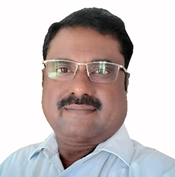M. Mayil Vaganan

Name: M. Mayil Vaganan
Qualification: M. Sc., Ph. D. (Plant Biochemistry)
Designation: Principal Scientist (Plant Biochemistry)
Department: Crop Production
College address: ICAR-National Research Centre for Banana,
Thayanur Post, Thogamalai Road, Tiruchirappalli – 620 102,Tamil Nadu
Award for: Research Excellence Award
Publication Title: Research Paper
Paper Title: Evaluation of different protein extraction methods for banana (Musa spp.) root proteome analysis by two-dimensional electrophoresis
Journal Name: Indian Journal of Biochemistry and Biophysics
Volume: 52
Issue No.: 1
Month of Publication: February
Year: 2015
Page No.: 101-106
ISSN : 0975-0959 (online) & 0301-1208 (print)
About M. Mayil Vaganan
Dr. Muthu Mayil Vaganan is at present Principal Scientist (Plant Biochemistry) with the ICAR-National Research Centre for Banana, Tiruchirappalli, India. He studied B. Sc. (Chemistry) at Thiagarajar College, Madurai under Kamaraj University, Madurai, Tamil Nadu and he obtained his master and doctoral degrees in Plant Biochemistry from the Indian Agricultural Research Institute, New Delhi. He has research experience of 25 years working mainly on coconut and banana. Working on coconut at the ICAR-Central Plantation Crops Research Institute, Regional Station, Kayangulam, Kerala, he purified phytoplasma, the causal pathogen of root (wilt) disease (RWD) of coconut and biochemically characterized and using purified phytoplasma bodies as antigen, mono- specific polyclonal antiserum was developed to use it in Ouchterlony double diffusion and ELISA tests to detect the diseased coconut palms. He identified a suitable phytoplasma-enriched DNA isolation method and developed a PCR-based detection method for the pathogen thus providing molecular credence to the phytoplasma etiology of coconut RWD. He identified isoenzymes peroxidase and polyphenol oxidase to detect incipient infection of phytoplasma in coconut seedlings and also distinguish RWD-tolerant and susceptible genotypes. He chemically synthesized ferrugineol, the aggregation pheromone of red palm weevil to use in IPM component. On banana, he has identified the phenolic metabolites conferring resistance to Pratylenchus coffeae nematode infection in banana and also identified the proteins differentially regulated during the infection of the nematode. He also developed a protocol for extraction of proteins from recalcitrant tissue of banana roots for proteomic analysis and identified the differentially expressed proteins with respect to salt and soil moisture deficit stresses in banana. He worked out and identified the 26 o C as threshold temperature for ‘green ripening’ of Cavendish bananas at temperature and low activity of pheophorphide a oxygenase as the biochemical factor responsible for green ripening. He also developed a method for enhancement of pre-harvest (in planta) and post-harvest green life of bananas using biochemicals meant for long time storage and transport. Detected presence of a low-glycemic sugar molecule of isomaltulose in banana fruit using metabolomics analysis and worked out glycemic indices (GI) of bananas at different ripening stages and found that GI of fruits with green tips is much lower than full ripe. Determined the anthocyanins contents and composition of banana flower bracts and macro-encapsulated them to us as ‘nutraceutical’. He also developed a chemical method for arresting the ‘finger drop’ in bananas. He has also developed a few transgenic lines of Grand Naine bananas with enhanced iron mineral contents through transgenic approach.
His areas of works presently are unraveling the ripening mechanism of banana fruit by proteomics; characterization of functional compounds of banana plant, identification of low-glycemic banana varieties and stage of fruit ripening and development of micronutrients biofortified bananas using transgenic tool. He has more than 50 research papers including 20 on banana and 23 popular articles to his credit. Participated 35 national and international conferences and presented 40 research papers. He has guided 15 M. Sc. and three Ph. D. students. He has undergone trainings in three overseas laboratories including one on metabolomics at Genomics Centre, University of California, Davis.